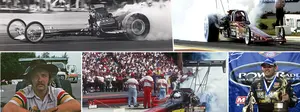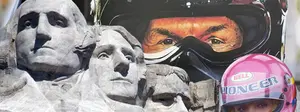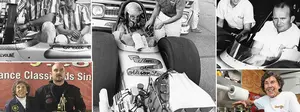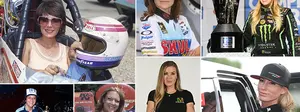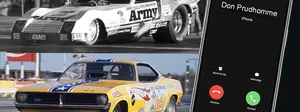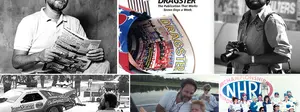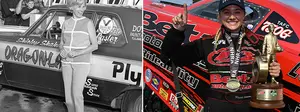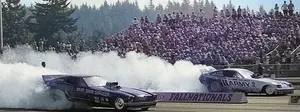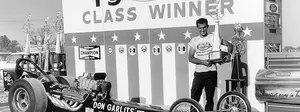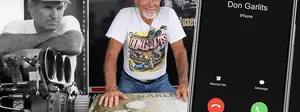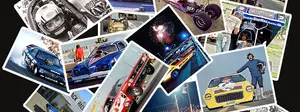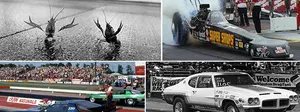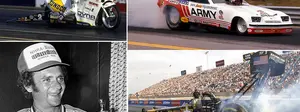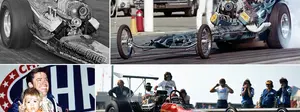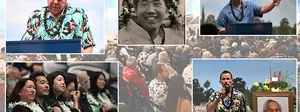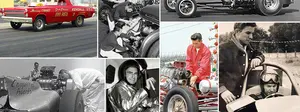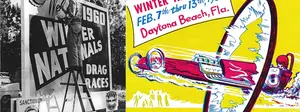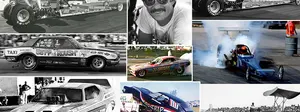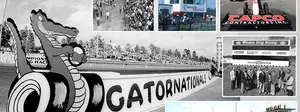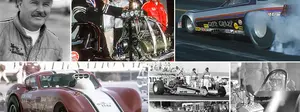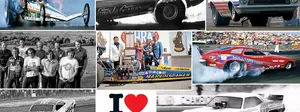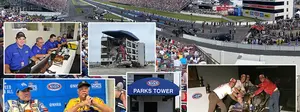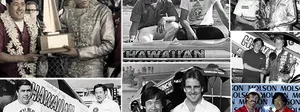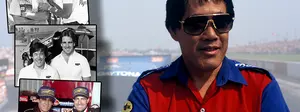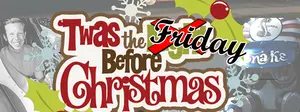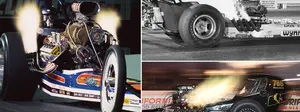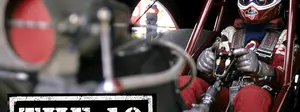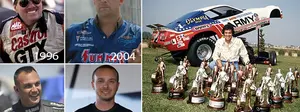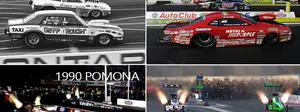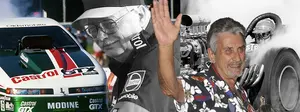Running out of film
It’s a crazy time of the year for those of us who follow the NHRA Mello Yello Drag Racing Series, with a stretch of four races in four weekends that just reached its midpoint last weekend with the inaugural event at New England Dragway. I was thrilled to be at the first race, and the venue is amazing. With no large VIP tower and just a small two-story announcing/timing tower, it looked like a very large match race from the '70s when the floppers came rolling around the bend and stacked up behind one another with their bodies up.
I get a pass this weekend while the rest of the ND troops are off to Chicago, but next week, I’m headed to my annual visit to Norwalk for the “big show” there, and if anyone knows anything about the Baders, they know that they know how to put on a big show. We’ll actually be traveling Wednesday (Thursday is the Fourth of July) and get a rare day on the road without race responsibilities, but it makes for a short week because we also have to finish National Dragster a day earlier than normal due to the holiday.
Anyway, the reason for this preamble is to warn that there might not be a column next Friday (depending on the situation) and to kick off this column, which I think will wrap up the photography thread that has been so much fun the last month. I’ve been accumulating bits and pieces along the way and thought I would blow them out here before moving on to fresh territory.
And away we go …
 |  |
Much love was heaped on Steve Reyes for his submissions of location-based photography and on the genre as a whole. Regular Insider contributor "Chicago Jon” Hofmann sent the funny-caption photo above left from Drag Racing USA that shows four of the greatest photographers from the '70s, from left, Reyes, Jon Asher, Tim Marshall, and Jim Kelly. If you read DRUSA back in the day, you know that Editor Mike Doherty helped make household names out of these guys by regularly talking/joking about them in the pages of his magazine. The group always seemed to hang together during their assignments and obviously had a good time doing it.
“I had lots of fun on tour with my buddies Asher and Kelly,” recalls Reyes. “I remember being told by Asher that when Kelly saw some of my early stuff, he told the other photographers in SoCal, 'I hope that kid never discovers color film.’ For me, that was the nicest thing a photographer like Kelly could say about me.”
Another of their traveling band of talented characters was Jere Alhadeff, who sent the clever photo above right, shot at Arizona’s Beeline Dragway during the 1973 AHRA Winternationals. “It’s a fish-eye shot and shows ‘Big Steve’ in comparison to the smaller-looking cars. I'm not sure if Reyes has ever seen this photo.”
Speaking of Alhadeff, who has also been very kind about sending photos and otherwise allowing me use of his images, he has agreed to send some of his location-based stuff (everyone remembers his shot of high school student Jeb Allen and his Top Fueler posed outside of his school that graced the cover of the July 1972 issue of DRUSA) for a future column.

 |
Reyes also was kind enough to send the photo above, showing the famous Alan Earman photo shoot of Tom McEwen’s Hot Wheels dragster surrounded by cheetahs at Southern California’s Lion Country Safari. (You’d never know it, but because Reyes’ scanner was on the fritz, it’s a photo of the magazine spread, from the June 1972 issue of DRUSA.) Reyes has said that this photo was the inspiration for his photo of the Rat Trap Funny Car surrounded by elephants at the same venue that I ran here a few weeks ago.
The whole setup is quite a funny story, as McEwen related in his book, Mongoose: The Life and Times of Tom McEwen. The car was built by Don Garlits, and McEwen was thrilled to have it. Immediately, “the Mongoose’s” ever-promotionally-minded wheels started spinning, and he put his head together with Earman, “searching for that special hook that would ensure us a fat feature in [DRUSA].”
“Our first thought was getting a bunch of real mongooses running around the car,” wrote McEwen. “Alan hooked up with the PR guy at Lion Country Safari, John Foxem, to see what we could work out. He thought it would make great press for the park and agreed to work with us. Unfortunately, they were fresh out of mongooses; I guess a field full of ugly rat-like critters wasn’t a big crowd-pleaser. Foxem suggested taking advantage of the park’s pride of cheetahs, the fastest animal – pure genius. Now how do we pull it off?”
Early one morning, before the park opened, they rolled the dragster out of the trailer into the midst of about a dozen cheetahs, who weren’t overly impressed or interested in the new addition to their environment and just sat there licking and scratching and dozing. The embarrassed animal keepers resorted to Plan B.
“Out came a couple of chopped-up sides of beef, tossed close to the car; it was like chumming for sharks,” recalled McEwen. “Suddenly, the atmosphere was charged with tension; these tabbies were fast returning to their true nature, all teeth and claws, guttural growls and snarls. We had quickly turned from curiosities to potential happy meals.
“After the feeding frenzy subsided, tensions eased up a bit, but the cats kept cruising around the car looking for any remaining tidbits. The keeper told me to start walking slowly to the car, which I did. The cheetahs were all around me, and one snarled low in his throat as I inched by. Getting to the car, I leaned against the slick. One of the cats just sat there, slowly tilting his head from side to side, sizing me up. It wasn’t a real comfortable feeling.
“Earman, also surrounded by cats, kept his cool, firing off several rolls of film. Fast wearing out our welcome, the keepers circled behind us and threw out more meat. The beasts quickly lost interest in our scrawny butts and headed for the newly present buffet. With our hearts finally returning to a fairly normal rhythm, we set the Olympic speed record for loading a race car!”

 |
Former National Dragster Editor Bill Holland has been enjoying the location photography and dropped me an email to talk about how he and partner John Guedel had the chance to have their dragster photographed in a couple of scenic environments in the late 1960s.
“When our National Automotive Specialties car was featured in Drag Racing magazine, we dragged it all over the place, including Travel Town in Griffith Park,” he remembered. “But one unique setting we came up with was the Los Angeles Department of Water and Power building downtown and a most interesting fountain. The car had just been painted (1967) by legendary Kustom Kar guy Bill Cushenberry in pearl white and cerise. Don't know if he ever did any more race cars, but he's credited as being an inventor of the 'water blade.' I did the lettering -- likely one of the first uses of chrome Mylar on a race car. No computers, it was hand-cut (with black One-Shot outline). [Tim Marshall photo]
“The following year (below), we raced our Art Linkletter's House Party car in Hawaii and took the opportunity to take it down on the beach on the east end of Oahu (I think it was Kailua). The volcanic rock lends an interesting touch.”
 |

 |
Speaking of the late, great Drag Racing USA, Mike Goyda, from whom I recently purchased more than two dozen vintage copies, sent this interesting tidbit about the demise of the magazine, which closed without notice after the June 1975 issue.
“The June '75 issue was the last, but there were two editions,” said Goyda. “The one on the left went to the newsstands and subscribers. The one on the right was printed in an extremely small run for photographers, staff, etc. I have had this in my personal collection for many years, having bought it from Jeff Tinsley, whose photo appears on the cover. This is the only example I have ever seen. Pretty cool, huh? Sad at the time, but a cool piece of memorabilia now.”
I was just 15 at the time but an avid reader, and I couldn’t understand why the July issue never showed up in the magazine rack at the local store where I used to buy my copies. Even though it was the preeminent drag racing magazine of its time, I think we all knew that it was in troubled financial times. They had (gasp!) raised the per-cost issue from 75 cents to a dollar in the summer of 1973, and then early in 1974, the formerly all-glossy paper was replaced in sections of the magazine with cheaper paper that honestly felt (and looked) even a grade below a grocery bag. While the change in paper stock was recognized in print, there was never any written warning about the magazine's demise in that last issue, which even promoted stories in the next issue, which, sadly, never arrived.

During my trip to New England, I was thrilled to have dinner (seafood, of course) with my “little sister,” Dawn Mazi-Hovsepian, and her husband, Mark, who live near the track. Anyone who knows my history knows of my infamous exploits with the Mazi family – driving their blown Opel, learning to ski, and flying (and by that I mean crashing) a hang glider -- in the summer of 1984 and how close I was to the family. Dawn and Mark are two of the top photographers who follow the nostalgia scene and a few years ago augmented their still photography with great and innovative video that is showcased on YouTube on her Drag Strip Riot channel.
“I started this channel in March of ‘09 with digitized analog footage I had (tying it in with our photography business and Drag Strip Riot poster series),” she told me. “Then I purchased a Canon HD video camera ‘10 and have been having a ball growing the channel since. I now have two Canons and two Drift POV cameras to collect footage with. Our 2012 Gasser Reunion highlight video is the most-viewed video of the channel and still maintains nearly 1,000 views per day -- impressive numbers to me since it’s not a crash video and that nostalgia drag racing is a niche of a niche. While I try to provide a variety of classes, my subscriber base is biased toward most everything with gassers. Steve Crook, who owns the AA/GS Blew By You 1956 Chevy, is from Eastlake, and my dad helped him make the transition from a carbureted to a blown small-block Chevy in 2011. There are currently four videos of Steve in the top 30 in less than two years. His popularity has risen very quickly.”
 |
Dawn also tells me that her father, Frank, one of the truly inspirational and supportive people in my life, is getting back behind the wheel very soon, taking the reins of a A/Fueler (pictured at right; alas, no blower), and that she’ll keep me informed of his progress. Even though he hasn’t driven a car for almost two decades, he has helped so many racers in the Cleveland area run their cars and mentored them in the sport. I haven’t seen Frank in, well, forever, but he’s supposed to be in Norwalk, and I plan to catch up with him there. I’m really looking forward to that reunion.
OK, that’s it for now. As I said earlier, next week’s column is subject to travel and weather and about a billion other things out of my control, so if you don’t see a new entry next Friday, at least you know why. If you’re an NHRA Member, you can check out the nostalgic photos today in the My Favorite Fuelers column on NationalDragster.net, which (in a nod to this weekend’s event in Chicago) takes a look at some of the legendary racers who have called the Windy City home, and next week’s column there, which will focus on Ohio’s nitro racing history as we head to the Buckeye State.
Have a safe and sane Fourth of July.


